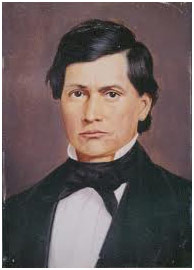
When a Chickasaw man found a girl that suited his fancy, he sent his mother or sister with a gift, perhaps enough calico to make one or more dresses tied up in a shawl or handkerchief, with instructions to ask the father and mother of the girl to give their approval of the intention of the suitor. If they gave consent, the bundle was handed to the girl. If she took it, the marriage bargain was considered made, and the man’s mother or sister took back the news.
The man then dressed himself head-to-foot in his best clothes, painted his face with vermilion and other paints and started for the residence of his intended wife. Upon reaching the house, he was invited to rest on a cowhide or the hide of any “varmint” generally used for seats in those days. After general topics of the day were discussed, supper was announced. The visitor and the intended father-in-law took supper alone, always without the company of the intended wife or her mother. Sometime after supper, a bed commonly occupied by the girl was prepared for the young couple. She retired before he entered the room. When the groom came in, he occupied the front side of the bed, and they were man and wife.
This, sir, was ancient marriage ceremony among the Chickasaws.
There were variations of the marriage ceremony, as there were with all traditions and customs. The ceremony performed depended upon family and locality.
(Excerpt from a letter written by Cyrus Harris in 1881, edited.)